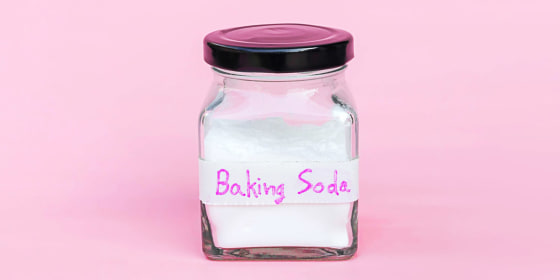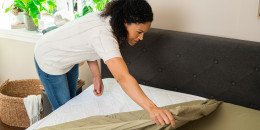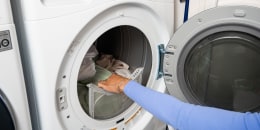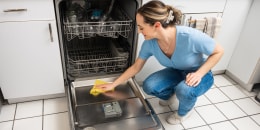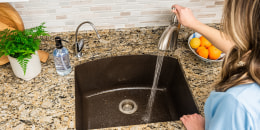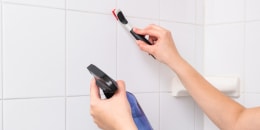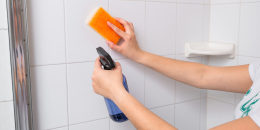Baking soda is the magic white powder that makes your baked goods rise. It puts the fluff in muffins, the height in pancakes and the layers in cake.
While baking soda is an important ingredient in many recipes, you might not always have it on hand. We’ve all been there: It’s time to bake a batch of cupcakes and you reach that point in the recipe when you have to spoon out a tiny amount of baking soda; you dip your measuring spoon in the box, only to have it come up empty.
If you’ve ever tried to use baking powder instead of baking soda, you know the mistake can lead to a change in taste and texture. So if you can’t always rely on using the similar sounding baking agent as a substitute, what can you use?
A quick Google search will show you that there are several ingredients you can use as a substitute for baking powder, like potassium bicarbonate (though, you’d also want to add more salt to offset the lack of sodium). We also have a list of ingredients you likely already have on hand — and if not, they might be easier to run out and pick up while you’re mid-bake.
So if you’ve run out of baking soda, don’t stress too much. Here are four usable swaps, two pitfalls to avoid and one piece of guidance for when all else fails.
Can you substitute baking powder for baking soda?
The answer here is: it depends.
The first thing you need to consider when debating a swap is what you’re making and what the other ingredients in the recipe are. Because of a whole lot of science that experts have previously explained to TODAY.com, baking powder doesn’t need additional acidic ingredients to activate.
Since baking soda is an ingredient of baking powder, baking powder is technically the best substitute for baking soda. Renée Gan, a food scientist who has amassed more than 25 years of experience working at major food companies like Kellogg’s and Kraft Foods, notes that any substitutions may change the texture and flavor of the final dish. Gan recommends using three times the amount of baking powder in lieu of baking soda. So, if a recipe calls for one teaspoon of baking soda, use three teaspoons (or one tablespoon) of baking powder.
(Be careful about swapping these two the other way, though — using baking soda where a recipe calls for baking powder might result in a heavy metallic taste.)
Egg whites
If you find yourself without baking powder or baking soda (and you’re not making a super complex recipe), try using egg whites.
“The proteins in egg whites lend physical structure to the baked product,” explains Gan, who recommends starting with two egg whites per teaspoon of baking soda.
First, pour the egg whites into a measuring cup and remove the same amount of liquid from the recipe. Before adding the egg whites to your mixture, whip them until they’re foamy and form soft peaks. The more air that’s incorporated, the better as it will provide some height to your treat.
Self-rising flour
Unlike all-purpose flour, which contains just one ingredient (wheat), self-rising flour is pre-mixed with a chemical leavening agent and, often, a bit of salt.
If you haven’t baked with self-rising flour before, it can be a little tricky since you can’t swap it with the regular stuff in a one-to-one ratio. Every cup of self-rising flour has about 1½ teaspoons of baking powder and 1/4 teaspoon of salt, so you’ll need to adjust your recipe accordingly.
Ammonium carbonate
According to Cook’s Illustrated, this ingredient (aka baker’s ammonia) was used before the invention of baking soda and baking powder.
While it can be used in place of both, they suggest doing so carefully. It’s reportedly best for crisp cookies like biscotti or thin and crispy chocolate chip cookies. If you’re making something cakey like a snickerdoodle, ammonium carbonate might not be your best bet.
You can find ammonium carbonate at some big box retailers, craft stores and specialty food shops.
The ingredient has an undeniably strong smell, but don’t worry — it will dissipate as your batter or dough bakes in the oven.
Club soda
While it’s not a great swap, club soda might be serviceable in some recipes.
As with the egg white method, you’ll want to remove an amount of liquid from your recipe equal to the amount of club soda you use.
“If you do try this approach, work quickly,” advises Gan. “Much of the carbon dioxide in the club soda will be lost in the air and won’t provide much leavening action.”
According to Gan, you’ll never get enough lift from club soda to make something super light and fluffy, so it’s not a foolproof baking soda substitute. If you have your heart set on making cake-like cookies or an angel food cake, take a trip to the grocery store and buy baking soda.
Simply go without it
For foods that don’t require too much leavening, such as cookies or pancakes, it’s actually OK to leave out the baking soda completely — they just won’t be as light and fluffy.
If you do go this route when making pancakes, Gan recommends pouring less batter into the pan to cover the same surface area. When making cookies, she advises flattening the cookie dough to avoid having a larger mass that won’t rise.
“The cookies will turn out to be crisper and the pancakes will turn out more like crepes,” says Gan. Also, don’t forget to adjust your baking times; the thinner your batter is, the faster it will bake.
Whatever you do, don’t reach for yeast
Although yeast is a popular leavening agent for making bread, it is not advisable to use it in place of baking soda.
“The mechanism is completely different,” says Gan. “Yeast is a living organism that requires different conditions to thrive (and) work. It will impart characteristics or flavors that you don’t necessarily want in your cake or cookie product.”
